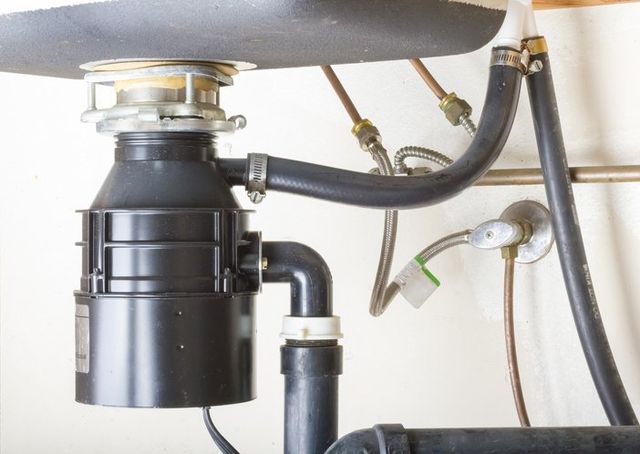My Guide to Resolving a Leak in Your Garbage Disposal
My Guide to Resolving a Leak in Your Garbage Disposal
Blog Article
The author is making several great pointers on the subject of The Handy Guide To Fixing Your Garbage Disposal Leaking overall in this article below.

Waste disposal unit are necessary kitchen area appliances that aid in disposing of food waste successfully. Nonetheless, a dripping garbage disposal can be an aggravating and unpleasant problem to deal with. Thankfully, several leaks can be fixed easily with a few straightforward actions. In this short article, we will review how to deal with a dripping garbage disposal effectively.
Intro
Garbage disposals are mounted under cooking area sinks and are designed to shred food waste right into smaller sized pieces, permitting it to go through the plumbing system easily. While these devices are usually trustworthy, leakages can occur with time because of wear and tear, loose connections, or damage to the device.
Typical Reasons For Leaks in Trash Disposals
Worn Seals and Gaskets
Seals and gaskets play a vital duty in preventing water from dripping out of the garbage disposal. In time, these parts can deteriorate, leading to leaks around the disposal system.
Loose Connections
The connections in between the waste disposal unit and the pipes system can become loosened over time, causing water to leak out throughout operation.
Cracks or Openings in the Disposal Unit
Physical damage to the garbage disposal, such as splits or holes in the real estate, can additionally cause leaks.
Recognizing the Resource of the Leak
Before trying to take care of a leaking waste disposal unit, it is necessary to recognize the source of the leakage. This can generally be done through aesthetic evaluation or by carrying out simple tests.
Visual Evaluation
Evaluate the garbage disposal system thoroughly for any indicators of water leak. Pay attention to areas around seals, gaskets, and connection factors.
Examining for Leaks
One way to examine for leaks is by running water via the disposal device and checking for any kind of visible indications of leak.
Devices and Materials Needed for Repairing a Leaking Garbage Disposal
Before starting the repair procedure, gather the required tools and materials, including a screwdriver, flexible wrench, plumbing technician's putty, substitute seals or gaskets, and epoxy or patching product for repairing splits or holes.
Step-by-Step Overview to Dealing With a Dripping Waste Disposal Unit
Turn Off the Power
Prior to trying any type of fixings, ensure that the power to the waste disposal unit system is shut off to avoid the threat of electric shock.
Find the Leakage
Identify the precise area of the leak and identify the reason.
Tighten Connections
Use a wrench to tighten up any kind of loose links in between the disposal unit and the plumbing system.
Change Seals or Gaskets
If the leak results from worn seals or gaskets, get rid of the old elements and change them with brand-new ones.
Patching Fractures or Holes
For cracks or openings in the disposal unit, usage epoxy or an ideal patching material to secure the damaged location.
Testing the Garbage Disposal After Fixing
As soon as the repair is full, test the waste disposal unit by running water with it to make certain that the leak has actually been dealt with.
Preventive Maintenance Tips to Stay Clear Of Future Leaks
To stop future leaks, it is important to carry out regular upkeep on your waste disposal unit. This includes keeping it clean, preventing putting non-food products or hard items down the disposal, and occasionally checking for leakages or various other problems.
Verdict
Finally, repairing a dripping waste disposal unit is a relatively straightforward process that can be finished with standard devices and products. By complying with the actions laid out in this article and practicing preventive maintenance, you can keep your garbage disposal in good working problem and prevent expensive repair services in the future.
HERE’S HOW TO FIX YOUR GARBAGE DISPOSAL
WHAT TO DO IF SOMETHING IS STUCK IN YOUR GARBAGE DISPOSAL
If the impeller won’t turn, there’s probably something stuck in the disposal. It could be a steak bone or peach pit, although plumbers report pulling all sorts of inappropriate objects out of disposals, such as bottle caps or aluminum foil. Make sure power to the disposal is off, and look inside to see if you can see the source of the jam.
Never stick your fingers in a disposal. Pull out anything you see with tongs or pliers.
If the disposal still won’t work, it may be time to call a plumber or consider buying a new disposal. GEM Plumbing & Heating is here for all of your garbage disposal needs.
WHAT TO DO IF YOUR GARBAGE DISPOSAL DRAIN IS CLOGGED
Take everything out from underneath your sink and put a bucket or other container under your disposal to catch any water that drains out. Disconnect your disposal from the power supply. If it’s plugged into a wall outlet, unplug it. If it’s hardwired into an electrical box, go to the electrical panel and turn off the breaker for the disposal. Pour ¼ cup of baking soda into the drain, followed by ½ cup of white vinegar. Give the solution a few minutes to fizz and do its work. Look into the disposal with a flashlight to see if you can see an object that might be causing the clog. If you see it, remove it using tongs or pliers. MORE TIPS ON DEALING WITH A CLOGGED GARBAGE DISPOSAL
Never use drain cleaner in a garbage disposal. It can damage the plastic parts inside the disposal. You can also be splashed with the caustic liquid while working to clear the clog. Beware! Never stick your fingers into a garbage disposal. Trust us — not a good idea. In many instances, your dishwasher drains through your garbage disposal. This allows the disposal to grind any large food particles that may be drained out of your dishwasher. There are some jurisdictions, however, where the plumbing code prohibits such a connection. WHAT TO DO WHEN YOUR DISHWASHER DRAINS THROUGH THE DISPOSAL
Run some water in the sink so your plunger has at least a ½-inch of water to create a seal and plunge vigorously up and down several times. You may need to repeat this several times. Run hot water down the drain to clear any residue that remains.

I am just very excited about Why Is and I hope you appreciated the post. If you appreciated our post plz be sure to pass it around. Many thanks for your time. Kindly come by our blog back soon.
Get Started Report this page